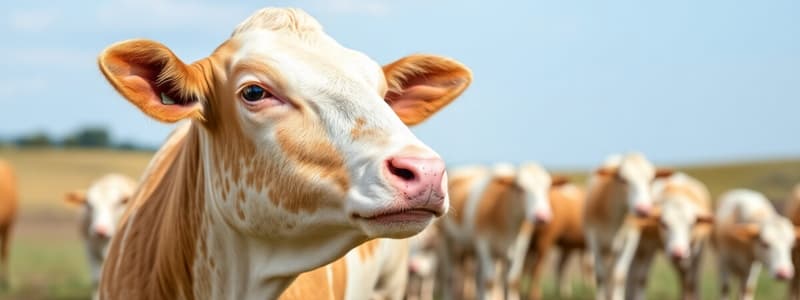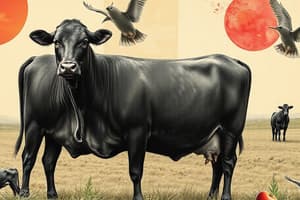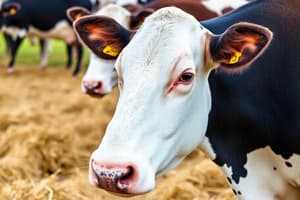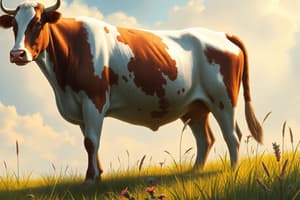Podcast
Questions and Answers
Explain how the principle of balancing an animal's ration ensures both their health and productivity. Give an example of a potential consequence of an imbalanced ration.
Explain how the principle of balancing an animal's ration ensures both their health and productivity. Give an example of a potential consequence of an imbalanced ration.
Balancing an animal's ration ensures provision of all essential nutrients in correct proportions, supporting optimal physiological function. An imbalanced ration can lead to deficiency diseases or metabolic disorders, reducing productivity and overall health.
Compare and contrast the roles of carbohydrates and lipids as energy sources in animal nutrition. Include an advantage of each.
Compare and contrast the roles of carbohydrates and lipids as energy sources in animal nutrition. Include an advantage of each.
Both carbohydrates and lipids provide energy, but lipids are a more concentrated source. Carbohydrates are readily available and easily metabolized. Lipids provide essential fatty acids and aid in hormone production.
Describe the significance of water in animal nutrition, explaining how it impacts nutrient utilization and overall survival.
Describe the significance of water in animal nutrition, explaining how it impacts nutrient utilization and overall survival.
Water is essential for nutrient transport, waste removal, temperature regulation, and various metabolic processes. Animals can survive longer without food than without water, highlighting its critical role in maintaining life.
How do the nutrient requirements for maintenance differ from those for production in animals? Provide specific examples for each.
How do the nutrient requirements for maintenance differ from those for production in animals? Provide specific examples for each.
Explain why understanding feed composition is crucial in animal nutrition, detailing how it influences the formulation of balanced rations.
Explain why understanding feed composition is crucial in animal nutrition, detailing how it influences the formulation of balanced rations.
Compare fat-soluble and water-soluble vitamins, explaining how their absorption, storage, and excretion differ in animals.
Compare fat-soluble and water-soluble vitamins, explaining how their absorption, storage, and excretion differ in animals.
What is the role of minerals in animal nutrition, and how does a deficiency in essential minerals like calcium or phosphorus impact animal health?
What is the role of minerals in animal nutrition, and how does a deficiency in essential minerals like calcium or phosphorus impact animal health?
Differentiate between roughages and concentrates in animal feed, providing examples of each and explaining their respective roles in an animal's diet.
Differentiate between roughages and concentrates in animal feed, providing examples of each and explaining their respective roles in an animal's diet.
Explain why expressing nutrient concentrations on a dry matter (DM) basis is important for comparing different feeds.
Explain why expressing nutrient concentrations on a dry matter (DM) basis is important for comparing different feeds.
A feed sample is found to contain 3% nitrogen. Calculate the estimated crude protein (CP) content of the feed.
A feed sample is found to contain 3% nitrogen. Calculate the estimated crude protein (CP) content of the feed.
Describe the limitations of using crude protein (CP) as a measure of protein quality in feed.
Describe the limitations of using crude protein (CP) as a measure of protein quality in feed.
What does a high ether extract (EE) value indicate about a feed, and why is this important in animal nutrition?
What does a high ether extract (EE) value indicate about a feed, and why is this important in animal nutrition?
Explain why neutral detergent fiber (NDF) and acid detergent fiber (ADF) are better indicators of fiber quality than crude fiber (CF).
Explain why neutral detergent fiber (NDF) and acid detergent fiber (ADF) are better indicators of fiber quality than crude fiber (CF).
A feed analysis report shows a high ash content. What does ash represent, and what implications might it have for animal nutrition?
A feed analysis report shows a high ash content. What does ash represent, and what implications might it have for animal nutrition?
Describe how nitrogen-free extract (NFE) is calculated, and discuss the limitations of using NFE as a measure of carbohydrate content.
Describe how nitrogen-free extract (NFE) is calculated, and discuss the limitations of using NFE as a measure of carbohydrate content.
Explain how the stage of maturity of a plant can affect its nutrient composition when used as feed.
Explain how the stage of maturity of a plant can affect its nutrient composition when used as feed.
Why is it important to consider anti-nutritional factors when formulating rations for animals, and give an example of how these factors can be mitigated?
Why is it important to consider anti-nutritional factors when formulating rations for animals, and give an example of how these factors can be mitigated?
Describe the key steps involved in ration formulation, and explain why this process is essential for optimizing animal production.
Describe the key steps involved in ration formulation, and explain why this process is essential for optimizing animal production.
Flashcards
Animal Nutrition
Animal Nutrition
Understanding nutritional needs of animals and meeting them through proper feeding.
Nutrients
Nutrients
Substances in food that support life, like carbs, proteins, and vitamins.
Ration
Ration
The amount of feed an animal consumes in 24 hours.
Diet
Diet
Signup and view all the flashcards
Digestion
Digestion
Signup and view all the flashcards
Absorption
Absorption
Signup and view all the flashcards
Water
Water
Signup and view all the flashcards
Roughages
Roughages
Signup and view all the flashcards
Concentrates
Concentrates
Signup and view all the flashcards
Proximate Analysis
Proximate Analysis
Signup and view all the flashcards
Dry Matter (DM)
Dry Matter (DM)
Signup and view all the flashcards
Crude Protein (CP)
Crude Protein (CP)
Signup and view all the flashcards
Ether Extract (EE)
Ether Extract (EE)
Signup and view all the flashcards
Crude Fiber (CF)
Crude Fiber (CF)
Signup and view all the flashcards
Ash
Ash
Signup and view all the flashcards
Nitrogen-Free Extract (NFE)
Nitrogen-Free Extract (NFE)
Signup and view all the flashcards
Neutral Detergent Fiber (NDF)
Neutral Detergent Fiber (NDF)
Signup and view all the flashcards
Acid Detergent Fiber (ADF)
Acid Detergent Fiber (ADF)
Signup and view all the flashcards
Study Notes
- Animal nutrition focuses on understanding the nutritional needs of animals.
- Proper feeding practices are critical to meeting nutritional needs.
- The field encompasses the study of nutrients, their functions, and how animals use them.
- These nutrients are used for maintenance, growth, reproduction, and production.
- Proper animal nutrition is critical for health, productivity, and welfare.
Key Concepts in Animal Nutrition
- Nutrients are substances in food that support life.
- A ration refers to the amount of feed an animal consumes in 24 hours.
- Diet is a blend of feedstuffs used to compose a ration.
- Digestion describes the process by which food is broken down into absorbable units.
- Absorption refers to the process by which nutrients are taken into the body.
- Metabolism includes the chemical processes in the body that maintains life.
Classes of Nutrients
- Water is important for temperature regulation, nutrient transport, and waste removal.
- Water is often overlooked, but is the most important nutrient.
- Animals can survive longer without food than without water.
- Carbohydrates are a primary energy source, mainly from plants, including sugars, starches, and fibers.
- Lipids (fats) serve as a concentrated energy source.
- Lipids provide essential fatty acids, and support hormone production and insulation.
- Proteins are composed of amino acids and are essential for building and repairing tissues.
- Proteins are involved in enzyme and hormone production.
- Minerals are inorganic substances needed for numerous physiological functions.
- Minerals needed include calcium, phosphorus, potassium, and various trace minerals.
- Vitamins are organic compounds that are required in small amounts for specific metabolic processes.
- Vitamins are classified as fat-soluble (A, D, E, K) or water-soluble (B vitamins, C).
Nutrient Requirements
- Maintenance includes nutrients needed to sustain basic body functions.
- Growth requires additional nutrients for increasing body size and tissue development.
- Reproduction relies on nutrients required for successful breeding, gestation, and lactation.
- Production needs nutrients for producing milk, eggs, meat, or wool.
- Specific requirements depend on the animal species, age, physiological state, and production level.
Feed Composition
- Feeds are made up of various nutrients in different proportions.
- Understanding feed composition is important for formulating balanced rations.
- Feeds are broadly classified into roughages and concentrates.
Roughages
- Roughages are high in fiber (more than 18% crude fiber) and lower in energy.
- These include forages like grasses, legumes, and silage.
- They are important for ruminants like cattle, sheep, and goats, because of their ability to digest fiber.
- They can be fresh, dried (hay), or ensiled (silage).
Concentrates
- Concentrates are low in fiber (less than 18% crude fiber) and high in energy and/or protein.
- They include grains (corn, barley, oats), oilseeds (soybeans, cottonseed), and byproduct feeds.
- Concentrates are used to supplement roughages.
- They are used to help meet the nutrient requirements of animals.
Proximate Analysis
- Proximate Analysis is a common method for determining the nutrient composition of feeds.
- It includes:
- Dry Matter (DM), or the amount of feed left after removing all water.
- Crude Protein (CP), which estimates the total protein content based on nitrogen content.
- Ether Extract (EE), which measures the fat content of the feed.
- Crude Fiber (CF), which measures the fiber content of the feed.
- Ash, or the mineral content of the feed.
- Nitrogen-Free Extract (NFE), which estimates the carbohydrate content of the feed.
Dry Matter (DM)
- DM represents the total solids in a feed sample.
- It is determined by drying a sample in an oven until all moisture is removed.
- Nutrient concentrations are expressed on a DM basis for accurate comparisons.
Crude Protein (CP)
- CP is estimated by multiplying the nitrogen (N) content of the feed by 6.25.
- The estimate assumes that proteins contain 16% nitrogen.
- CP does not distinguish between true protein and non-protein nitrogen (NPN).
Ether Extract (EE)
- EE determines the fat content by extracting the feed sample with ether.
- It measures all substances soluble in ether, including fats, oils, waxes, and pigments.
- EE provides an approximation of the energy content of the feed.
Crude Fiber (CF)
- CF measures the indigestible carbohydrate fraction of the feed.
- This is primarily composed of cellulose, hemicellulose, and lignin.
- CF values are decreasing in preference for NDF and ADF.
Ash
- Ash represents the total mineral content of the feed.
- It is determined by burning the feed sample in a furnace.
- Ash includes essential minerals like calcium, phosphorus, and trace minerals.
Nitrogen-Free Extract (NFE)
- NFE is calculated by subtracting the sum of CP, EE, CF, and Ash from 100.
- It represents the readily digestible carbohydrate fraction of the feed, namely sugars and starches.
- NFE is subject to error because it accumulates the errors from the other analyses.
Neutral Detergent Fiber (NDF)
- NDF represents the total fiber content of the feed.
- This includes cellulose, hemicellulose, and lignin.
- NDF is related to the feed intake of the animal.
Acid Detergent Fiber (ADF)
- ADF represents the cellulose and lignin content of the feed.
- ADF is related to the digestibility of the feed, and lignin is indigestible.
Importance of Feed Analysis
- Feed analysis provides data for formulating balanced rations.
- It helps meet the nutrient requirements of animals.
- It aids in evaluating the quality of feedstuffs.
- Feed analysis can also help in diagnosing nutritional deficiencies or imbalances.
- The analysis is essential for optimizing animal production and health.
Factors Affecting Nutrient Composition of Feeds
- Plant species and variety affects nutrient profiles.
- Stage of maturity affects nutrient content as plants mature.
- Soil fertility impacts nutrient availability in the soil and subsequently in the plants.
- Climate (temperature, rainfall, sunlight) affects plant growth and composition.
- Storage conditions affect nutrient losses upon improper storage.
Anti-Nutritional Factors
- Some feeds contain substances that can interfere with nutrient absorption or utilization.
- Examples include Trypsin inhibitors in soybeans, Glucosinolates in rapeseed, and Tannins in certain forages.
- Proper processing methods (e.g., heat treatment) can reduce anti-nutritional factors.
Feed Additives
- These are non-nutritive substances added to feeds to improve animal performance or health.
- Examples include antibiotics, which promote growth and prevent disease, and probiotics, which improve gut health.
- Enzymes can enhance nutrient digestion, while antioxidants can protect against oxidative stress.
Ration Formulation
- Ration formulation is designing a feeding plan that meets the nutrient requirements of animals.
- This includes determining the animal's nutrient requirements, and evaluating the nutrient composition of available feedstuffs.
- Can be completed by calculating the amounts of each feedstuff needed to meet the animal's needs manually or using computer software.
Feeding Management
- Feeding Management is the practical application of nutritional principles.
- It ensures that animals receive adequate and balanced nutrition.
- Actions include providing access to clean water and offering feed in appropriate quantities.
- Also involves monitoring animal body conditions and adjusting rations as needed, and preventing feed wastage and contamination.
Conclusion
- Animal nutrition is a critical component of animal health and productivity.
- Understanding nutrient requirements and feed composition is essential for balanced rations and effective feeding.
Studying That Suits You
Use AI to generate personalized quizzes and flashcards to suit your learning preferences.




